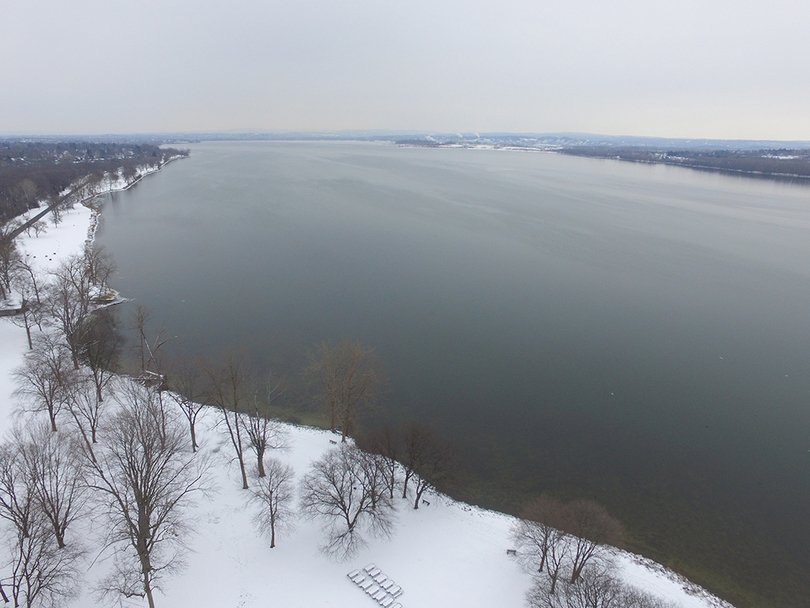Despite Onondaga Lake remedial efforts, some blame corporate influence for blocking lake’s full restoration

Brandon Bielinski | Contributing Photographer
Honeywell International is the major potentially responsible party for the pollution, said Joe Health, general counsel for the Onondaga Nation. The company is the successor to Allied Corp. and the Solvay Process Company, companies largely responsible for the early contamination of the lake, he added.
UPDATED: Feb. 26, 2017 at 10:15 p.m.
Recreational trails surround the shores of Onondaga Lake, but warning signs read “Please Stay on Trail” — a reminder of the contamination that plagued the area for decades.
Although the water quality has improved over the past five years, Onondaga Lake and surrounding areas are still grappling with the effects of pollution today — the latest issue being a toxic site near Destiny USA, for which a remediation proposal is currently under a period of public comment.
Joe Heath, general counsel for the Onondaga Nation, which considers the lake sacred, said Honeywell International is the major potentially responsible party for the pollution. The company is the successor to Allied Corp. and the Solvay Process Company, companies largely responsible for the early contamination of the lake, he said.
In 1994, the government recognized the contamination of Onondaga Lake and related upland sites by adding it to the Federal Superfund National Priorities List, according to the New York State Department of Environmental Conservation. A Superfund site is land that has been contaminated and poses a risk to the environment and/or human health, per the United States Department of Health and Human Services.
Heath said for most Superfund sites, one factory or one leak caused the problem, but dozens of problems have contributed to the overall pollution of Onondaga Lake, once considered the most polluted lake in America.
Honeywell entered a consent decree with the DEC to implement a remediation plan in 2007, and began dredging work in 2012, per the DEC. The plan was crafted by engineers, scientists, researchers and the community, according to the Onondaga Lake Cleanup website.
About 450 acres of the lake were capped — meaning that, essentially, sand was poured on them — and 2.2 million cubic yards of material were removed, according to the cleanup website. But some argued the cleanup plan was not enough.
“You need to get all that out of here,” Heath said. “You can’t take 10 percent or 5 percent out and then try to cover it up or contain it.”
Honeywell has been involved with many Superfund sites, one of the most recent being Hoosick Falls, New York. Honeywell spokeswoman Victoria Streitfeld would not specify the number of Superfund sites Honeywell is involved with.
“Honeywell works on remediation projects throughout the country related to our legacy businesses,” she said.
Prior to the Industrial Revolution, Onondaga Lake thrived as a source of food and water. It was central to the life of the Haudenosaunee, and the indigenous history of the lake can be traced back over 1,000 years, said Gregg Tripoli, executive director of the Onondaga Historical Association.

Daily Orange File Photo
The Haudenosaunee consider the lake sacred, as it was on the lakeshore that the Great Law of Peace was born — the effort that brought five warring nations together to create the Haudenosaunee Confederacy. The confederacy was the first representative democracy in the west and served as an inspiration to the founding fathers of the U.S., Tripoli said.
Major lake pollution started during the Industrial Revolution when Solvay Process began producing soda ash, Heath said. There were no environmental laws, he said, and for every pound of soda ash created, the company produced 1.5 pounds of waste that was dumped into the lake for decades.
The company later dumped waste onto the lakeshore, creating wastebeds. The wastebeds are now the site of the Lakeview Amphitheater. A 2014 Syracuse.com article revealed it would cost $6.5 billion and take 30 years to completely clean the industrial wastebeds, which is what the Onondaga Nation advocated for. But this process would have involved tearing up six miles of Interstate 690, ripping out a bike trail extension and eliminating the site where the amphitheater is now located.
Instead, Honeywell proposed spending $16 million to $20 million to cover the wastebeds with soil and plants, which “would protect human health and the environment,” per the article.
Justin Sayles, a county spokesman, said in a statement that the amphitheater has been cleared for public use.
“No site that has been more studied or monitored than the Lakeview Amphitheater site,” Sayles said. “In fact the United States Environmental Protection Agency, the New York State Department of Health and the New York State Department of Environmental Conservation have all certified the amphitheater site to be safe for the public.”
Still, Heath said, building the amphitheater on covered wastebeds is a serious problem.
“We have the county and the state inviting people to go there … without taking the waste out,” Heath said. “And they know this, but they have calculated, ‘Oh, it’s just a little carcinogenic vapor.’”
When the amphitheater was proposed, Heath’s office helped form a coalition to try to stop it, but it was still constructed. Lindsay Speer, director of Creating Change, a public relations consulting business that works with nonprofits and native nations, said infrastructure and walking trails should not have been built unless the waste was removed in its entirety.
“The more people that buy into the idea that the lake is clean, the less clean it will ever be,” Speer said. “It’s a paradox.”
Other sources of pollution to the lake are the General Electric plant, the General Motors factory and Niagara Mohawk, Heath said. Twenty-six different toxic chemicals can be found in the bottom of the lake.
Onondaga County is another party significantly responsible for the contamination of the Lake, Heath said, due to sewage being dumped into the water. When it rains excessively, the runoff combines with the sewage and causes the pipes to overflow into a tributary of Onondaga Lake.
After years of legal complaints and evaluations that called for an upgrade of the sewer system, the county turned to green infrastructure — such as rain gardens and green roofs — that was implemented in 2008 with the help of Onondaga County Executive Joanie Mahoney, Speer said. This eventually became the Save the Rain program, and improved lake health.
Along with successful remediation came setbacks. Efforts to cap contaminants found in the lake have failed three times. The DEC, EPA and Honeywell evaluated the areas at fault and identified modified cap designs which were implemented in 2016, said Kevin Fraizer, a public relations representative for the DEC, in an email. All areas are currently stable, he said.
Neil Patterson Jr., a Tuscarora and assistant director of the Center for Native Peoples and the Environment, said the Onondaga Nation has made it clear that it is not supportive of the cleanup plan. Remediation and restoration of the lake is the primary vision of the Onondaga Land Rights Action, a case started by the Onondaga Nation that was dismissed in federal court. There are ongoing efforts by the nation to further that case, Patterson said.
“On the very basis of the work that has been done to date, the Nation is not content with the amount of material that is left in place,” Patterson said. “They have been very vocal and clear that these failures of the caps on the contaminants in the lake and the design of the caps itself are an indication that we may not see a day where there is a fully remediated lake.”
Patterson said, from his understanding, the responsible parties in the contamination have it in their best interest to minimize the cost of the cleanup.
Heath said he believes Honeywell is engaging in a “very elaborate corporate spin” as a means of saving money.
“You can spend hundreds of millions on lawyers, spin, political contributions, building playgrounds … constantly getting people to say ‘It’s clean, it’s clean and you can swim there,’” Heath said. “Well it’s not clean, people shouldn’t swim there.”
Heath’s office has been outspoken with its opposition to the current remediation efforts, and they worked with many lawyers who focus on environmental law to write criticisms of the remediation plan that were always ignored, he said.
“People cannot afford to litigate against large, well-funded corporations,” Heath said. “The county gets to choose: Do you get a few hundred thousand dollars … or do you spend millions ending up settling anyway because you can’t afford to continue the litigation?”
CORRECTION: In a previous version of this article, there were a series of statements made by a source without proper evidence that the assertions were correct. The story has since been updated for accuracy.




